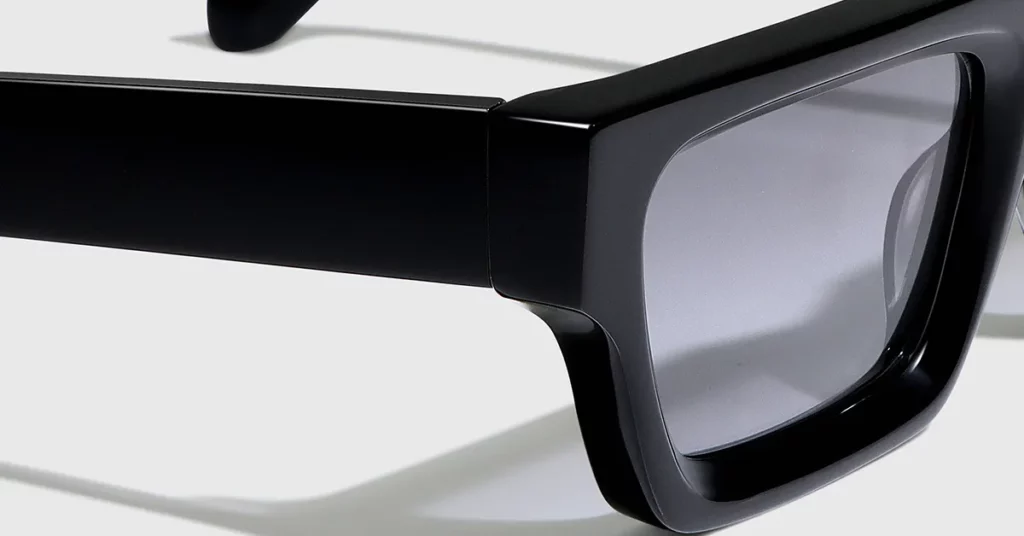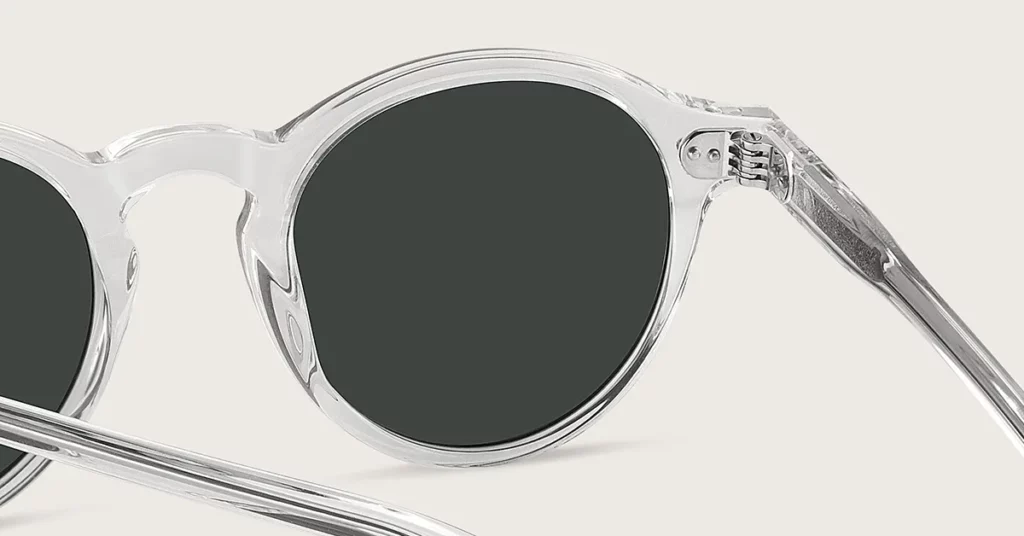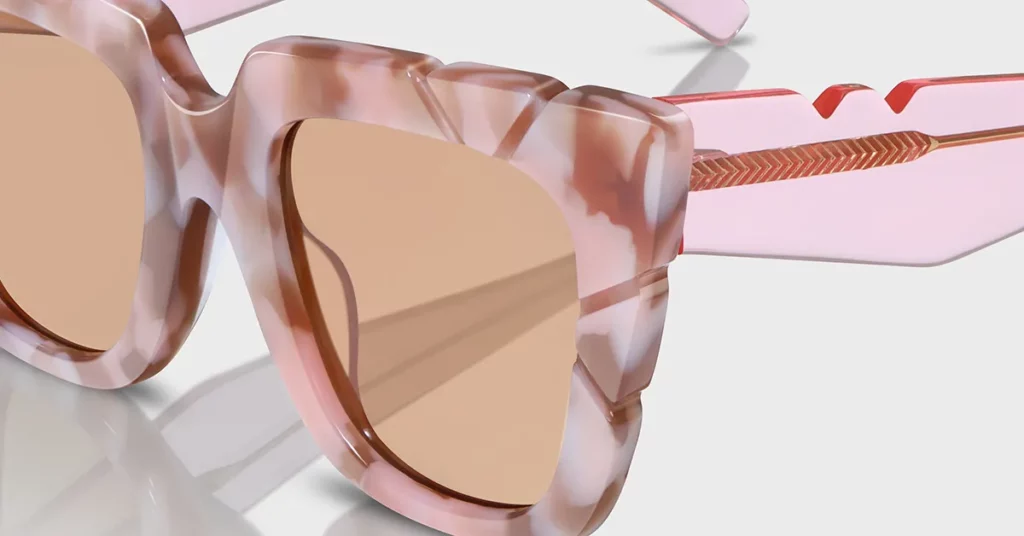Matte vs. Glossy Finishes: A Founder’s Guide to Choosing the Right Acetate Frame
The core difference is in how the surface is treated. A glossy finish is polished smooth, making it shiny, oil-resistant, and vibrant, but prone to showing micro-scratches. A matte finish is bead-blasted for a non-reflective look that hides scratches well but is more porous and susceptible to discoloration from skin oils.
At a Glance: Key Differences
To start, let’s directly compare the core attributes of each finish. Understanding these trade-offs is the first step in aligning a finish with your brand’s specific goals and your customer’s expectations.
| Feature | Glossy Acetate | Matte Acetate |
| Visual Effect | Reflective, vibrant colors | Light-diffusing, muted tones |
| Surface Feel | Smooth and polished | Velvety and soft |
| Brand Alignment | Classic luxury, bold statements | Modern minimalism, tech aesthetic |
| Scratch Visibility | Shows micro-scratches easily | Hides minor scuffs well |
| Oil Resistance | Excellent, easy to wipe clean | Prone to absorbing oils over time |
| Maintenance | Simple cleaning | Requires proactive care cream |
| Cost Impact | Standard pricing | Typically a 10-15% premium |
The Bottom Line: Your choice is a trade-off between the proven, low-maintenance durability of glossy and the modern, tactile appeal of matte. Neither is better, but one will be better for your brand.

Decision Factor 1: Aesthetics and Feel
The finish you choose fundamentally defines the first impression your frames make. It dictates how light interacts with the surface and how the frame feels against the skin, shaping your customer’s initial perception of quality.
The Glossy Finish: Vibrant and Classic
A glossy finish provides a classic, high-shine look. This is achieved through extensive polishing, which creates a highly reflective surface that makes acetate colors and patterns appear deeper and more vibrant. Think of it like putting a high-gloss varnish on a piece of wood—it instantly brings out the richness and complexity of the material beneath.
The Matte Finish: Understated and Modern
A matte finish offers a contemporary, velvety-soft surface. This finish diffuses light rather than reflecting it, which creates a sophisticated, understated appearance that feels modern and technical. The soft texture also provides a unique tactile experience that many customers associate with quiet luxury.
How Finish Impacts Color
This difference is most obvious when you work with complex patterns like tortoiseshell. A glossy finish will make the pattern’s colors “pop,” creating a rich, dynamic look. A matte finish, in contrast, will soften the pattern, making it appear more subtle and integrated.
Tactile Feel and Grip
From a functional standpoint, the texture of a matte frame often provides a slightly better grip against the skin. This can reduce the feeling of the frames slipping down the nose, a small but important factor in the all-day comfort your customers will notice.

Decision Factor 2: Durability and Long-Term Wear
How a frame ages is just as important as how it looks out of the box. You need to understand how each finish performs over time to set the right customer expectations and minimize potential issues.
Oil and Stain Resistance
- Glossy’s Approach: The polishing process creates a hard, non-porous surface that is exceptionally resistant to skin oils, sweat, and cosmetics. This sealed barrier prevents substances from penetrating the acetate, making the frames easy to clean and far less likely to discolor.
- Matte’s Approach: The porous nature of a matte surface means it’s more susceptible to absorbing oils. Over time, this can lead to a “hazy” or milky discoloration in high-contact areas.
- The Verdict: For sheer stain and oil resistance, glossy is superior. It’s the most reliable choice for customers who prioritize low-maintenance durability.
Scratch and Blemish Visibility
- Glossy’s Approach: The highly reflective surface of a glossy finish acts like a mirror, making micro-scratches and fingerprints very noticeable.
- Matte’s Approach: A matte finish excels at hiding minor scuffs, fingerprints, and daily wear. Its textured, light-diffusing surface camouflages small imperfections that would stand out on a glossy frame.
- The Verdict: For hiding minor, everyday blemishes, matte has the clear advantage. However, a deep, major scratch can be more disruptive to a uniform matte texture.
Repair and Restoration
- Glossy’s Approach: A huge benefit of glossy acetate is its repairability. A skilled technician can often professionally buff out scratches and restore the original luster, extending the life of the frames.
- Matte’s Approach: Repairing a scratch on a matte surface is much more difficult. It’s nearly impossible to perfectly replicate the original bead-blasted texture in one small area, so damage is often permanent.
- The Verdict: Glossy frames are far easier to restore. You can confidently market them as a long-term, restorable investment.

Decision Factor 3: Manufacturing and Cost
Understanding how each finish is made reveals why there are differences in cost, lead time, and quality control. This knowledge is essential for your production planning.
How a Glossy Finish is Made
The glossy finish is the result of a multi-stage polishing process. After frames are cut, they are tumbled for days in barrels with wood chips to smooth all surfaces. They are then polished with progressively finer compounds before a final hand-buffing creates a flawless, liquid-like depth.
Business Implication: This is the industry-standard process for premium acetate. It represents the baseline cost and production timeline you can expect from a quality manufacturing partner.
How a Matte Finish is Made
Creating a matte finish requires additional steps. A frame must first be fully polished, just like a glossy one. Then, it undergoes a controlled bead-blasting process, where tiny pellets create the uniform, light-diffusing texture. Afterward, the frame must be sealed with a special cream to close its pores.
Business Implication: These extra steps require more time and specialized equipment. Always budget for a 10-15% cost premium and a slightly longer lead time when choosing a matte finish.
Common Mistake: New designers often assume matte is “unpolished” and should be cheaper. In reality, a premium matte finish requires more work than a glossy one, not less.

Decision Factor 4: Brand Identity Alignment
Your finish choice is a powerful signal. It instantly communicates your brand’s personality, target audience, and position in the market. You must ensure this signal is aligned with your core message.
Aligning Finish with Your Brand Archetype
The surface of your frames is a silent ambassador. You must avoid the amateur branding mistake of choosing a finish that contradicts your story. The goal is to make your frame’s finish reinforce its identity and price point before a customer even tries it on. Use this matrix to guide your strategic choice.
| Brand Archetype | Recommended Finish | Strategic Rationale |
| Classic Luxury | Glossy | Communicates heritage, timeless appeal, and premium materials. |
| Modern Minimalist | Matte | Reinforces understated sophistication and contemporary values. |
| Bold Creator | Glossy | Enhances color vibrancy, making a statement piece more impactful. |
| Understated Pro | Matte | Projects quiet competence and professional reliability. |
| Heritage Craftsman | Glossy | Honors traditional manufacturing and classic design techniques. |
| Tech-Forward | Matte | Aligns with a modern tech aesthetic and innovation. |
Pro Tip: Use this framework to justify your decision to your team. It transforms a subjective aesthetic choice into a data-driven branding decision, helping you build consensus and confidence.

Conclusion
Your choice of finish is a critical business decision, not merely an aesthetic one. It impacts your brand perception, manufacturing costs, and the long-term experience of your customers. For new brands, a glossy finish is the safest path, offering proven durability and simple maintenance. For brands aiming to capture a modern, design-forward audience, a matte finish is a powerful differentiator, provided you commit to educating your customers on its proper care.
Frequently Asked Questions
1. Is a matte or glossy finish more expensive to produce?
Matte finishes typically cost 10-15% more. This is because they require the standard polishing process plus additional manufacturing steps like bead-blasting and surface sealing.
2. Do matte frames get dirty more easily?
Because their surface is microscopically porous, matte frames can absorb skin oils more readily than sealed glossy frames. However, they are much better at hiding fingerprints and minor smudges.
3. Can you polish scratches out of a matte acetate frame?
Attempting to polish a scratch on a matte frame will make that spot glossy, permanently altering the finish. Unlike glossy frames, matte frames cannot be easily spot-repaired to their original texture.
4. Why do my matte frames look white or chalky?
This “hazy” or white discoloration is caused by the absorption of skin oils, sweat, or cosmetics into the porous surface. It can be prevented with regular cleaning and the use of a specialized care cream that seals the acetate’s pores.
5. Which finish is more popular right now?
Matte finishes have grown in popularity, especially with brands focused on minimalist and modern design. However, glossy remains the timeless standard for classic, luxury, and heritage brands. The right choice depends entirely on your brand’s target audience.